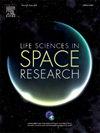Dose measurements with the Pille-ISS thermoluminescent dosimeter system during extravehicular activities (2004-2022)
IF 2.8
3区 生物学
Q2 ASTRONOMY & ASTROPHYSICS
引用次数: 0
Abstract
One of the most problematic goals for radiation safety during spaceflight is an assessment of additional doses received by astronauts during extravehicular activity (EVA). The Pille-ISS thermoluminescent dosimeter developed by the predecessor of the Hungarian Research Network (HUN-REN) Centre for Energy Research (Budapest, Hungary) is designed for the routine dose measurements not only inside the spacecraft compartments, but also for personal dosimetric control for EVA. During almost two decades of the International Space Station (ISS) operation, the unique set of 131 EVA doses were recorded in different conditions, such as: solar activity, ISS trajectory along the South Atlantic Anomaly (SAA), and shielding conditions provided by two kinds of spacesuits: the Extravehicular Mobility Unit (EMU) and Orlan.
The EVA dose rates during the normal scenario (without SAA crossing during EVA) are: 26 Gy/h on average, with maximum value of 118 Gy/h for the EMU spacesuit; and 103 Gy/h on average, with maximum value of 255 Gy/h for the Orlan spacesuit. However, the corresponding EVA dose can increase by about 33% on average regardless the spacesuit type, depending on time spent in SAA. The worst case mean EVA dose is equivalent to 7 days inside the ISS with 2.423 mGy. In general, the possible additional radiation risk due to the EVA is small in comparison with typical half-year mission onboard the ISS.
The long-term experience of EVA dose assessments with Pille-ISS dosimeter shows that in some cases the skin dose can be underestimated due to the excessive shielding of the standard Pille-ISS dosimeter. To solve this problem, the modified Pille-ISS dosimeters with significantly reduced shielding are developed and involved onboard the ISS for the dose measurements starting from 2023.
在舱外活动期间使用pill - iss热释光剂量计系统进行剂量测量(2004-2022)。
航天飞行期间辐射安全最成问题的目标之一是评估宇航员在舱外活动(EVA)期间接受的额外剂量。由匈牙利研究网络(HUN-REN)能源研究中心(匈牙利布达佩斯)的前身开发的pilille - iss热致发光剂量计不仅用于航天器舱内的常规剂量测量,而且用于EVA的个人剂量控制。在国际空间站(ISS)近20年的运行中,在不同的条件下记录了131个独特的EVA剂量,例如:太阳活动,沿南大西洋异常(SAA)的国际空间站轨道,以及两种太空服(舱外活动单元(EMU)和Orlan)提供的屏蔽条件。正常情况下(舱外无SAA交叉)的舱外剂量率为:平均26 μGy/h, EMU航天服最大剂量率为118 μGy/h;平均值为103 μGy/h, Orlan宇航服最大值为255 μGy/h。然而,无论太空服类型如何,根据在SAA中停留的时间,相应的EVA剂量平均可增加约33%。最坏的情况下,平均EVA剂量相当于在国际空间站内呆7天,为2.423兆gy。总的来说,与国际空间站上典型的半年任务相比,舱外活动可能带来的额外辐射风险很小。用Pille-ISS剂量计进行EVA剂量评估的长期经验表明,在某些情况下,由于标准Pille-ISS剂量计的过度屏蔽,皮肤剂量可能被低估。为了解决这一问题,我们研制了屏蔽性能显著降低的改进后的Pille-ISS剂量计,并将从2023年开始在ISS上进行剂量测量。
本文章由计算机程序翻译,如有差异,请以英文原文为准。
求助全文
约1分钟内获得全文
求助全文
来源期刊

Life Sciences in Space Research
Agricultural and Biological Sciences-Agricultural and Biological Sciences (miscellaneous)
CiteScore
5.30
自引率
8.00%
发文量
69
期刊介绍:
Life Sciences in Space Research publishes high quality original research and review articles in areas previously covered by the Life Sciences section of COSPAR''s other society journal Advances in Space Research.
Life Sciences in Space Research features an editorial team of top scientists in the space radiation field and guarantees a fast turnaround time from submission to editorial decision.
 求助内容:
求助内容: 应助结果提醒方式:
应助结果提醒方式:


